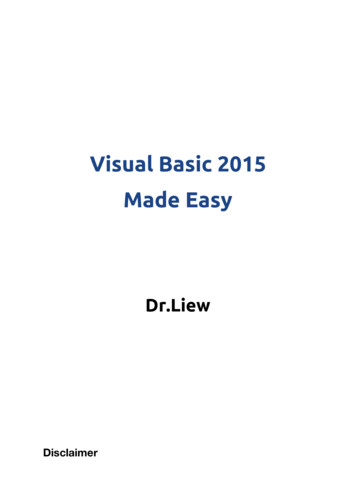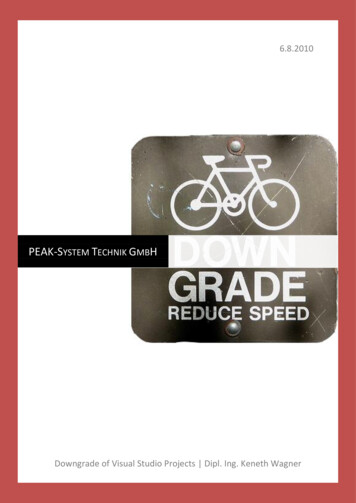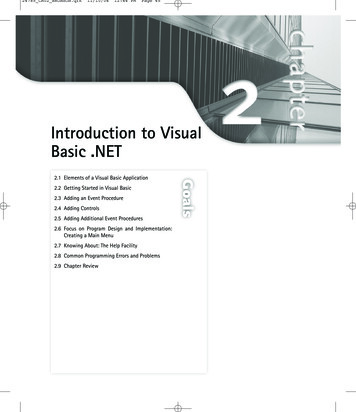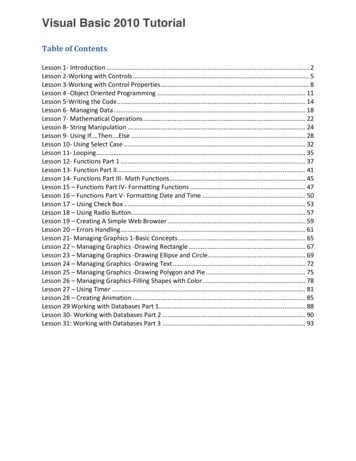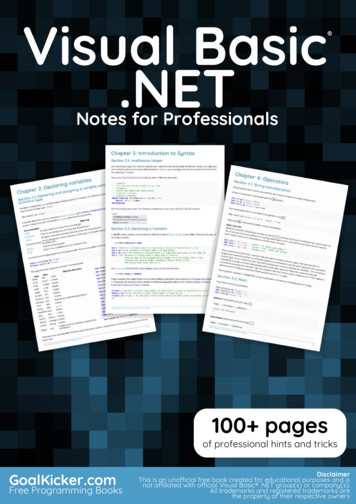
Transcription
Visual Basic.NETVisual Basic .NETNotes for Professionals Notes for Professionals100 pagesof professional hints and tricksGoalKicker.comFree Programming BooksDisclaimerThis is an uno cial free book created for educational purposes and isnot a liated with o cial Visual Basic .NET group(s) or company(s).All trademarks and registered trademarks arethe property of their respective owners
ContentsAbout . 1Chapter 1: Getting started with Visual Basic .NET Language . 2Section 1.1: Hello World . 2Section 1.2: Hello World on a Textbox upon Clicking of a Button . 2Section 1.3: Region . 3Section 1.4: Creating a simple Calculator to get familiar with the interface and code . 4Chapter 2: Declaring variables . 8Section 2.1: Declaring and assigning a variable using a primitive type . 8Section 2.2: Levels of declaration – Local and Member variables . 10Section 2.3: Example of Access Modifiers . 11Chapter 3: Introduction to Syntax . 14Section 3.1: Intellisense Helper . 14Section 3.2: Declaring a Variable . 14Section 3.3: Comments . 15Section 3.4: Modifiers . 15Section 3.5: Object Initializers . 16Section 3.6: Collection Initializer . 17Section 3.7: Writing a function . 19Chapter 4: Operators . 21Section 4.1: String Concatenation . 21Section 4.2: Math . 21Section 4.3: Assignment . 22Section 4.4: Comparison . 23Section 4.5: Bitwise . 23Chapter 5: Conditions . 25Section 5.1: If operator . 25Section 5.2: IF.Then.Else . 25Chapter 6: Short-Circuiting Operators (AndAlso - OrElse) . 27Section 6.1: OrElse Usage . 27Section 6.2: AndAlso Usage . 27Section 6.3: Avoiding NullReferenceException . 27Chapter 7: Date . 30Section 7.1: Converting (Parsing) a String to a Date . 30Section 7.2: Converting a Date To A String . 30Chapter 8: Array . 31Section 8.1: Array definition . 31Section 8.2: Null Array Variables . 31Section 8.3: Array initialization . 32Section 8.4: Declare a single-dimension array and set array element values . 32Section 8.5: Jagged Array Initialization . 32Section 8.6: Non-zero lower bounds . 32Section 8.7: Referencing Same Array from Two Variables . 33Section 8.8: Multidimensional Array initialization . 33Chapter 9: Lists . 34Section 9.1: Add items to a List . 34Section 9.2: Check if item exists in a List . 34
Section 9.3: Loop through items in list . 34Section 9.4: Create a List . 35Section 9.5: Remove items from a List . 36Section 9.6: Retrieve items from a List . 36Chapter 10: Enum . 38Section 10.1: GetNames() . 38Section 10.2: HasFlag() . 38Section 10.3: Enum definition . 39Section 10.4: Member initialization . 39Section 10.5: The Flags attribute . 39Section 10.6: GetValues() . 40Section 10.7: String parsing . 40Section 10.8: ToString() . 41Section 10.9: Determine whether a Enum has FlagsAttribute specified or not . 41Section 10.10: For-each flag (flag iteration) . 42Section 10.11: Determine the amount of flags in a flag combination . 42Section 10.12: Find the nearest value in a Enum . 43Chapter 11: Dictionaries . 45Section 11.1: Create a dictionary filled with values . 45Section 11.2: Loop through a dictionary and print all entries . 45Section 11.3: Checking for key already in dictionary - data reduction . 45Section 11.4: Getting a dictionary value . 46Chapter 12: Looping . 47Section 12.1: For.Next . 47Section 12.2: For Each.Next loop for looping through collection of items . 48Section 12.3: Short Circuiting . 48Section 12.4: While loop to iterate while some condition is true . 50Section 12.5: Nested Loop . 50Section 12.6: Do.Loop . 51Chapter 13: File Handling . 53Section 13.1: Write Data to a File . 53Section 13.2: Read All Contents of a File . 53Section 13.3: Write Lines Individually to a Text File using StreamWriter . 53Chapter 14: File/Folder Compression . 54Section 14.1: Adding File Compression to your project . 54Section 14.2: Creating zip archive from directory . 54Section 14.3: Extracting zip archive to directory . 54Section 14.4: Create zip archive dynamicaly . 54Chapter 15: Connection Handling . 55Section 15.1: Public connection property . 55Chapter 16: Data Access . 56Section 16.1: Read field from Database . 56Section 16.2: Simple Function to read from Database and return as DataTable . 57Chapter 17: Type conversion . 58Section 17.1: Converting Text of The Textbox to an Integer . 58Chapter 18: ByVal and ByRef keywords . 59Section 18.1: ByRef keyword . 59Section 18.2: ByVal keyword . 59Chapter 19: Console . 61
Section 19.1: Console.ReadLine() . 61Section 19.2: Console.Read() . 61Section 19.3: Console.ReadKey() . 61Section 19.4: Prototype of command line prompt . 61Section 19.5: Console.WriteLine() . 62Chapter 20: Functions . 63Section 20.1: Defining a Function . 63Section 20.2: Defining a Function #2 . 63Chapter 21: Recursion . 64Section 21.1: Compute nth Fibonacci number . 64Chapter 22: Random . 65Section 22.1: Declaring an instance . 65Section 22.2: Generate a random number from an instance of Random . 65Chapter 23: Classes . 67Section 23.1: Abstract Classes . 67Section 23.2: Creating classes . 67Chapter 24: Generics . 69Section 24.1: Create a generic class . 69Section 24.2: Instance of a Generic Class . 69Section 24.3: Define a 'generic' class . 69Section 24.4: Use a generic class . 69Section 24.5: Limit the possible types given . 70Section 24.6: Create a new instance of the given type . 70Chapter 25: Disposable objects . 71Section 25.1: Basic concept of IDisposable . 71Section 25.2: Declaring more objects in one Using . 71Chapter 26: NullReferenceException . 73Section 26.1: Empty Return . 73Section 26.2: Uninitialized variable . 73Chapter 27: Using Statement . 74Section 27.1: See examples under Disposable objects . 74Chapter 28: Option Strict . 75Section 28.1: Why Use It? . 75Section 28.2: How to Switch It On . 75Chapter 29: Option Explicit . 77Section 29.1: What is it? . 77Section 29.2: How to switch it on? . 77Chapter 30: Option Infer . 78Section 30.1: How to enable/disable it . 78Section 30.2: What is it? . 78Section 30.3: When to use type inference . 79Chapter 31: Error Handling . 81Section 31.1: Try.Catch.Finally Statement . 81Section 31.2: Creating custom exception and throwing . 81Section 31.3: Try Catch in Database Operation . 82Section 31.4: The Un-catchable Exception . 82Section 31.5: Critical Exceptions . 82Chapter 32: OOP Keywords . 84
Section 32.1: Defining a class . 84Section 32.2: Inheritance Modifiers (on classes) . 84Section 32.3: Inheritance Modifiers (on properties and methods) . 85Section 32.4: MyBase . 86Section 32.5: Me vs MyClass . 87Section 32.6: Overloading . 88Section 32.7: Shadows . 88Section 32.8: Interfaces . 90Chapter 33: Extension methods . 91Section 33.1: Creating an extension method . 91Section 33.2: Making the language more functional with extension methods . 91Section 33.3: Getting Assembly Version From Strong Name . 91Section 33.4: Padding Numerics . 92Chapter 34: Reflection . 94Section 34.1: Retrieve Properties for an Instance of a Class . 94Section 34.2: Get a method and invoke it . 94Section 34.3: Create an instance of a generic type . 94Section 34.4: Get the members of a type . 94Chapter 35: Visual Basic 14.0 Features . 96Section 35.1: Null conditional operator . 96Section 35.2: String interpolation . 96Section 35.3: Read-Only Auto-Properties . 97Section 35.4: NameOf operator . 97Section 35.5: Multiline string literals . 98Section 35.6: Partial Modules and Interfaces . 98Section 35.7: Comments after implicit line continuation . 99Section 35.8: #Region directive improvements . 99Chapter 36: LINQ . 101Section 36.1: Selecting from array with simple condition . 101Section 36.2: Mapping array by Select clause . 101Section 36.3: Ordering output . 101Section 36.4: Generating Dictionary From IEnumerable . 101Section 36.5: Projection . 102Section 36.6: Getting distinct values (using the Distinct method) . 102Chapter 37: FTP server . 103Section 37.1: Download file from FTP server . 103Section 37.2: Download file from FTP server when login required . 103Section 37.3: Upload file to FTP server . 103Section 37.4: Upload file to FTP server when login required . 103Chapter 38: Working with Windows Forms . 104Section 38.1: Using the default Form instance . 104Section 38.2: Passing Data From One Form To Another . 104Chapter 39: Google Maps in a Windows Form . 106Section 39.1: How to use a Google Map in a Windows Form .
Visual Basic .NET Visual Basic Notes for Professionals .NET Notes for Professionals GoalKicker.com Free Programming Books Disclaimer This is an uno cial free book created for educational purposes and is not a liated with o cial Visual Basic .NET group(s) or
